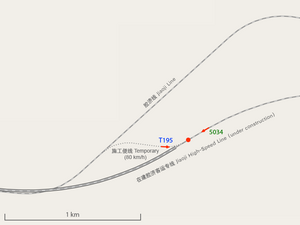|
Zibo train collision
The Zibo train collision (Chinese: “4·28”胶济铁路特别重大交通事故) was a major train collision that occurred on the morning of April 28, 2008, near the city of Zibo, in Shandong province, People's Republic of China. The collision occurred on the Jiaoji Railway, which links the important cities of Qingdao and Jinan in Shandong province. With a death toll of 72 people and 416 injuries, the collision was the deadliest rail accident in the People's Republic of China since a 1997 accident in Hunan.[1] ContextThe Jiaoji railway is a trunk line that is about a century old, built originally by Germans in the area during the late Qing dynasty. The collision gained international attention as Beijing was preparing to host the 2008 Olympics, and occurred during the Olympic torch relay. It was notable also as the deadliest accident of China's railway system since an accident in Hunan in April 1997. It was the second accident on the Jiaoji Railway line during 2008, the first involving a train that killed 18 railway workers in January. SynopsisTrain T195 was an express passenger train from Beijing to Sifang railway station in Qingdao. It derailed at 04:38 China Standard Time (CST) on the inside (left) track around a bend due to excessive speed, at around 500 meters east of Wangcun Railway Station. In all, carriages 10 to 18 derailed on the scene. Those in carriages one to nine were relatively unaffected. Train 5034 was a regular passenger train from Yantai destined for Xuzhou, coming from the other direction on the outside track at the regulated speed of 80 km/h. As the derailment of T195 became visible to the drivers, it was too late to stop the train. Train 5034 collided with the derailed cars at the K290+940 meters mileage marker on the double-tracked Jiaoji Railway at approximately 04:41 CST,[2] three minutes after the derailment of T195. At this point, cars nine to 16 of T195 derailed and blocked the parallel track that Train 5034 was on. The first three cars of Train 5034 reportedly fell into a ditch. As Train T195 derailed, it turned 90 degrees on its side. As most people were asleep during the time of the derailment, some only became aware after the incident had occurred. As passengers exited, many around the area were making frantic calls on their mobile telephones, temporarily causing a malfunction of the local telephone network.[3] The collision caused 72 fatalities[4] and 416 injuries.[5] It occurred when train T195 was on a section of the railway track undergoing maintenance ahead of the 2008 Olympics.[6] The section was a temporary railway and the speed limit was 80 km/h (50 mph), but T195 was traveling at 131 km/h (81 mph).[1] Timeline
Response The city of Zibo sent out 130 ambulances to the site of the crash and activated 34 medical stations. Some 700 medical personnel were on site. CPC General-secretary, President Hu Jintao and Premier Wen Jiabao both released directives after the accident occurred, and sent Vice-Premier Zhang Dejiang to inspect rescue and investigation efforts. Wang Jun, as head of the State Administration of Work Safety was named head of the investigation committee. Liu Zhijun, the Railways Minister, alongside Shandong party secretary Jiang Yikang and Governor Jiang Daming were also on-site.[7] China's Guangming Daily blamed the crash on "holes in the management of the Jiaoji Railway", stating that it is "highly unlikely" that two accidents can occur on the same railway three to four months apart.[8] The Financial Times remarked that although the accident would be blamed on human error, it was likely that funding shortfalls played a role.[9] On May 26, 2009, the State Council issued the investigative report on the collision. A total of 37 people were found to be partly responsible for the accident. The executive vice-director of the Jinan Railway Bureau and six others were subject to criminal charges, and 31 other related personnel were accorded some sort of disciplinary action. Of these, Chen Gongxing, manager of the Jinan Railway Bureau, was dismissed; Chai Tiemin, the party chief of the Bureau, was also sacked.[10] See alsoReferencesWikinews has related news:
|
||||||||||||||||||||||||||||||||
Portal di Ensiklopedia Dunia
